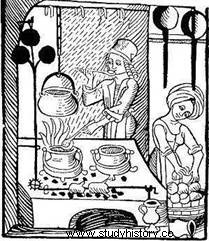 Medieval recipes are very different from our current cuisine. But contrary to what one might think, they are full of finesse, slightly tart, colorful, spicy and non-greasy. Most sauces accompanying poultry and fish are rather acidic (wine, vinegar, verjuice). Very popular, sweet and sour flavors are obtained by adding sugar, honey or fruit. The spices used in large quantities are mainly cinnamon and ginger, followed by powdered cloves, nutmeg, mace, maniguette or seeds of paradise, pepper, cardamom, galangal (garingal) and finally saffron to color. The visual aspect of food in the Middle Ages is almost as important as the taste. As a result, the dishes obtained have beautiful colors of green, yellow, orange, …
Medieval recipes are very different from our current cuisine. But contrary to what one might think, they are full of finesse, slightly tart, colorful, spicy and non-greasy. Most sauces accompanying poultry and fish are rather acidic (wine, vinegar, verjuice). Very popular, sweet and sour flavors are obtained by adding sugar, honey or fruit. The spices used in large quantities are mainly cinnamon and ginger, followed by powdered cloves, nutmeg, mace, maniguette or seeds of paradise, pepper, cardamom, galangal (garingal) and finally saffron to color. The visual aspect of food in the Middle Ages is almost as important as the taste. As a result, the dishes obtained have beautiful colors of green, yellow, orange, …
Recipe reference works from the Middle Ages
There are two 14th century medieval cookbooks:
Le Mesnagier de Paris was written in 1393 by a Parisian magistrate. This book was to be used by his 15-year-old wife to become an excellent housewife. Principles and precepts for leading one's house and household. Advice so that she is docile and entirely submissive to her husband.
 Le Viandier was written by Guillaume Tirel, dit Taillevent. He would have been born in 1320/1326 and died around 1395. Thanks to his beginnings as a kitchen boy in the kitchens of Queen Jeanne d'Evreux, he became a "potagier" (specialist in stews and simmered cooking), he rose through the ranks. His colleagues nicknamed him “Taillevent”. In In 1346, he became head chef to King Philip VI, then entered the service of the Dauphin, Duke of Normandy, and continued to direct his kitchens when the latter was crowned king. Under Charles VI, he reached the pinnacle of glory, being appointed kitchen squire and master of the king's garrisons. In 60 years, he will have served 5 kings. He will die filled with money and honours, possessing coats of arms which will recall his function as a cook. For the record:the museum of Saint Germain en Laye has a tombstone from the sacristy of the church of the Priory of Hanemont.
Le Viandier was written by Guillaume Tirel, dit Taillevent. He would have been born in 1320/1326 and died around 1395. Thanks to his beginnings as a kitchen boy in the kitchens of Queen Jeanne d'Evreux, he became a "potagier" (specialist in stews and simmered cooking), he rose through the ranks. His colleagues nicknamed him “Taillevent”. In In 1346, he became head chef to King Philip VI, then entered the service of the Dauphin, Duke of Normandy, and continued to direct his kitchens when the latter was crowned king. Under Charles VI, he reached the pinnacle of glory, being appointed kitchen squire and master of the king's garrisons. In 60 years, he will have served 5 kings. He will die filled with money and honours, possessing coats of arms which will recall his function as a cook. For the record:the museum of Saint Germain en Laye has a tombstone from the sacristy of the church of the Priory of Hanemont.
Taillevent is, in a way, the ancestor of generations of artists who have forever marked the history of gastronomy, and even history itself. During his life he wrote a recipe book, known today as Viandier by Taillevent.
Medieval recipes:starters
Improvised soup
For 4 people:750 ml of beef or chicken broth, 1 tbsp. vinegar, 3 tbsp. verjuice, 2 eggs, 80g of breadcrumbs, 1 pinch of ginger, 1 pinch of nutmeg, 1 pinch of saffron, 1 pinch of cloves, 3g of salt
Heat the broth, beat the eggs, mix them with the hot broth, remove from the heat, beating with a whisk. Add the breadcrumbs, then the spices dissolved in the verjuice and vinegar. Cook for a few minutes while stirring and serve.
Rocket Picada
1 pound of arugula (kind of salad), 2 tbsp. Banyuls vinegar soup, 12 walnut kernels, 1 tsp. coffee of sugar, pepper, 1 pinch of filaments of saffron, 4 capsules of cardamom, 1/2l of olive oil.
Blanch the arugula for 5 minutes in boiling water. Purée it in a blender with the nuts. Add the sugar and spices as well as the vinegar. Mix well. Whisk in mayonnaise with olive oil. This sauce is perfect for fish or cold meat.
Green broth of eggs and cheese
Take some parsley, a little cheese and sage and a little saffron, some soaked bread, and dilute with pea broth or boiled water, grind and strain; put crushed ginger, dilute with wine and boil, then put cheese in it and poached eggs in water; and let it be cheerful (tender) green.
Item, some don't put bread in it; instead of bread, bacon goes well.
Herb omelette
6 tansy leaves, 1 rue leaf, 4 ache leaves (wild celery), 4 mint leaves, 4 sage leaves, 6 marjoram leaves or oregano, 1 handful of fennel, 1 large handful of parsley, 2 handfuls of a mixture of violet leaves, spinach, lettuce, green chard, 16 eggs, 1 tbsp. coffee ginger, salt.
Wash the herbs, chop them and put them in a salad bowl. Add eggs, ginger, and beat. Make 2 equal parts, for 2 omelettes. Cook in a very hot pan with a knob of butter. Enjoy hot. You can add a little cream cheese to the cooking. The Ménagier de Paris recommends putting the grated cheese on the omelet while it is cooking and not before, in the beaten eggs, so that the cheese does not stick to the bottom of the pan. It indicates to eat the omelet neither too hot nor too cold.
Brouet à la mode de Savoie
For 4 people:1 l chicken broth + 1 slice of smoked bacon + 2 chicken livers + 2 slices of toast + 1 half teaspoon of powdered ginger + 1 pinch of powdered cinnamon + 1 pinch of saffron + 1 bunch of parsley + salt.
Cook the diced smoked bacon in a pan with a little fat, add the chicken livers and cook together for 5 minutes. Take the bacon and the livers and mix them with the toast, the parsley and the spices except the saffron. Add a small ladle of chicken broth if needed. Heat the broth and pour in the previous preparation, stirring to mix everything well. Heat for 10 mins. Then add the saffron and serve hot.
Yellow Soup
For 4 people:400g of salmon, 150g of whole peeled almonds, 25cl of verjuice, 25cl of white wine, 75cl of water, 20g of fresh ginger (1 piece of 4cm), 1 clove, 1 tsp. coffee seeds of paradise, 10 filaments of saffron, 1 tsp. tablespoon oil, salt.
Remove the skin and bones from the salmon. In a casserole, sauté the fish for 5 minutes. in oil. Crumble finely with a fork. Put the almonds in the blender. Mix the verjuice, wine and water. Add crushed almonds and crumbled fish. Grind the ginger in a blender, crush the clove, add these 2 spices to the fish, as well as the salt, saffron and the seed of paradise. Bring to a boil and simmer for 5 min.
Almond Milk Soup
For 4 people:250g of almonds, 300g of onions, 1 liter and a half of water, 3 slices of sandwich bread, 25g of butter.
Peel the onions and cook them in water for 20 min. Scald the almonds, peel them and pass them through the blender. Add them to the onion cooking water. Filter through Chinese. Chop the cooked onions, brown them in the butter. Add to almond milk. Heat and pour over the slices of bread.
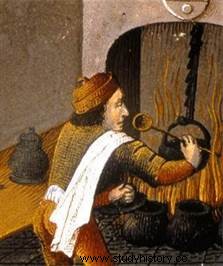 White porée, creamy purée of white leeks
White porée, creamy purée of white leeks
For 4 people:1.5 kg of leeks, 200g of onions, 200g of whole peeled almonds, 10g of fresh ginger (1 piece of 2cm), 30cl of water , 50g of butter. A mixture of spices:1 pinch of cardamom, ½ tsp. coffee cinnamon, 1 pinch of nutmeg.
Peel the leeks and keep only the whites. Chop them and the onions. Brown them in butter for 10 minutes. Grind the almonds in the blender. Mix with water to make a thick milk. Filter. Combine vegetables and almond milk. Add crushed ginger. Boil 10 mins. Serve sprinkled with the spice mix.
Cold Sage
For 4 people:1 chicken, 2 tbsp. tablespoons of wine vinegar, 8 slices of white bread, 2 hard-boiled egg yolks, 2 crushed cloves, 10 filaments of saffron, 1 tbsp. tablespoon powdered ginger, 8 shelled and crushed cardamom pods, 1 tsp. cinnamon powder, 1 tsp. chopped sage, 2 tbsp. tablespoons chopped parsley, salt and pepper.
Put the chicken in a court-bouillon. Boil it for an hour. Cut it into pieces. Baste bread with broth. Switch to the blender. Add hard-boiled eggs. Grind again. Add a little broth to obtain a fairly liquid cream, then the spices, herbs, vinegar, salt, pepper. Beat with a fork. Pour over the chicken pieces and serve very cold.
Pea cream:the ancestor of 18th century veloutés
For 4 people:400g of peas, 1 heart of lettuce, 1 onion, 100g of heavy cream, 25g of butter, 4 sprigs of chervil, salt and pepper.
Shell the peas, peel the onion and chop. Wash the heart of the lettuce and cut into thin strips. Melt the butter in a 4l casserole dish and add the onion. Brown it for 3 minutes over low heat, stirring constantly. Add the lettuce and mix for 2 minutes. Pour in the chicken broth and as soon as it boils, add the peas. Cook for 20 mins until tender. Salt, pepper. Reserve 4 tbsp. Put the rest in the blender. Sieve the cream obtained then pour it back into the pan. Heat until boiling, add the fresh cream, mix and remove from the heat. Serve garnished with reserved peas and chervil.
Recipes of medieval dishes
Poultry stew
For 6 people:1 free-range chicken + 25 cl of dry white wine + 75 cl of chicken broth + butter or lard + salt and pepper. For the sauce:1 slice of bread + 1 teaspoon ground ginger + 1 teaspoon powdered cumin + 6 cl verjuice or 5 cl white wine and 1 teaspoon wine vinegar + 2 egg yolks eggs.
Cut the chicken into pieces. Cover them with chicken broth and wine. Simmer gently for around 40 mins. Adjust seasoning. Remove the chicken pieces and keep warm.
Prepare the sauce. Reduce the cooking juices of the chicken until you obtain about 30 cl of liquid then melt the bread in it over low heat. Dissolve the spices in the verjuice (or the white wine/vinegar mixture) and mix with the broth. Bring to a simmer and strain through cheesecloth.
When ready to serve, brown the chicken pieces in a little fat until golden brown. Beat the egg yolks. Reheat the sauce and pour in the eggs, whisking. Bring to a simmer and remove from heat. Cover the meat with this hot sauce.
Rabbit stew with spices
For 4 people:1 rabbit (about 1.4 kg), 30g of oil, 70g of toasted country bread, 150g of wine, 80g of a good vinegar red wine, 500g beef or chicken broth, 60g verjuice, 250g onions, 2 tbsp. ginger, 1/2 tsp. coffee cinnamon, 1 pinch of ground cloves, 1/4 tsp. coffee nutmeg, 1/4 tsp. pepper, 1/4 tsp. coffee maniguette, 2 g salt
Roast a rabbit on the grill or on a spit, cut it into pieces. Sauté the onions. Sauté the rabbit pieces and onions. Deglaze with the vinegar and reduce a little.
Toast the bread, then dip it in the broth and wine. Mix, add the powdered spices that have been dissolved in a spoonful of verjuice, add the rest of the verjuice. Mix with rabbit. Cook together for 3/4 hours. Civé must be "brown, spiced up with vinegar and moderate in salt and spices".
Roast lamb with salt menu
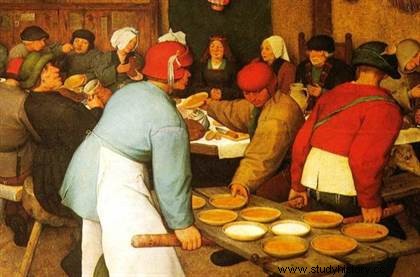 For 4 people:1 shoulder of lamb weighing 1.5kg, 30 heads of parsley, verjuice, vinegar, flower of salt.
For 4 people:1 shoulder of lamb weighing 1.5kg, 30 heads of parsley, verjuice, vinegar, flower of salt.
Cook the shoulder in a hot oven (230°) for 20 min. Take it out of the oven. Make cuts deep enough to accommodate the parsley sprigs. Put back in the oven for 20 minutes. Serve with the "jance, cameline and green" sauces, as well as with cups of fine salt, vinegar and verjuice that each guest can use as seasoning as they wish.
Pike with green sauce
For 4 people:1 pike weighing 1.20 kg + court-bouillon + salt and pepper. For the green sauce:1 bunch of parsley + 3 or 4 sorrel leaves + 1 teaspoon of ginger + 1 teaspoon of grains of paradise or pepper + 1 half-teaspoon of marjoram + 1 slice of bread of white bread + 20 cl of fish stock + 5 cl of lemon juice + 50 g of butter.
In the bowl of a blender, place the parsley, sage, sorrel, marjoram, bread crumbs soaked in fish stock and lemon juice as well as the crushed spices. Mix everything well and pass everything through a cheesecloth, pressing well to recover all the juices. Pour the mixture into a saucepan and bring to a simmer. Add the butter while whisking.
Place the fish in the cold court-bouillon, gently bring to a simmer and cook for around 15 minutes. Lift the fillets, remove the bones.
Pour the hot green sauce at the bottom of each plate and place the fish fillets on top after checking the seasoning with salt and pepper.
This sauce accompanies all poached fish.
Fish Rissolles
(nothing to do with fish, a fish day is called a lean day)
It's actually stuffed donuts, the dough recipe for which is not given.
Cook chestnuts over low heat; peel them as well as hard-boiled eggs that you will chop finely with cheese. Then pour egg whites on top and add fine spice powder and a tiny bit of fine salt, and make your rissoles; fry them in plenty of oil and sugar. Normally the rissoles are made with figs, grapes, roasted apples and peeled walnuts to counterfeit the pignolat, and fine powdered spices. The dough must be well colored with saffron. The rissoles are then fried in oil. If necessary add starch and rice to bind.
Hot
For 4 people:4 pike or salmon steaks + 1 slice of country bread + 20 cl of fish stock + 5 cl of white wine + 5 cl of verjuice + 1 teaspoon of ground or powdered ginger + 1 clove of crushed cloves + 1 teaspoon of seeds of paradise or pepper + 1 pod of saffron + 50 g of butter + salt.Toast the bread, cut it into small pieces and soak them in the fish stock. Grind the spices and mix them with the white wine and the verjuice then with the fish stock. Bring to a simmer and cook for about 5 to 10 minutes for the sauce to thicken slightly. Strain through cheesecloth, pressing well. Add the saffron threads. Keep warm. Cook the pieces of fish under the broiler, turning halfway through or in a skillet. Lightly salt. Reheat the sauce at the last moment and off the heat, incorporate the very cold butter, whisking to bind the sauce. Serve the fish topped with sauce.
Galimafrée
For 4 people:600 g of cooked leg of lamb + 2 onions + 1 glass of white wine + 3 cl of verjuice + 1 pinch of powdered ginger + salt and pepper + lard.
Fade the sliced onions in a little lard. Chop a third of the meat. Add it to the onions and sauté gently. Pour in the white wine and simmer for a few minutes. Add ginger and pepper. Dice the rest of the meat and add it to the previous mixture. Simmer 10 mins. Check the seasoning and when serving, deglaze with the verjuice.
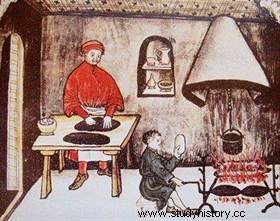 Garlic, cheese, raisin and spice pie
Garlic, cheese, raisin and spice pie
For a pie:shortcrust pastry (500g flour, 1 egg, 180g butter, 10g salt, water), 600g fresh cheese, 200g peeled garlic, 200g bacon, 100g raisins, 3 eggs, saffron, 1 tbsp. ginger, 1 tsp. cinnamon, ½ tsp. coffee nutmeg, ¼ tsp. clove coffee, 1/8 tsp. pepper.
Make the shortcrust pastry. Cook the peeled garlic in boiling water for 10 to 15 minutes and soak in cold water. Mix the drained garlic and continue adding the cheese and spices. Mix with the diced bacon, then the eggs, the raisins. Line a mold with part of the dough, pour the mixture and cover with the rest of the dough (weld the edges).
Bake in a hot oven (230°C) for about 1 hour.The engraved crayfish
For 4 people:Court bouillon (1 onion, 10 sprigs of parsley, 1 clove of garlic, ½ stalk of celery, 1 sprig of basil, 1 sprig of thyme, 1 sprig of bay leaf), 2 kg of crayfish, 50g of powdered almonds, 50g of toast, ½ tsp. cinnamon, 10 seeds of paradise, 10g chopped ginger, 1 clove, 1 pinch of saffron, ½ lemon juice or 1 dash of vinegar.
Cook the court-bouillon for about 10 min. Immerse the crayfish for 4 to 5 min. Separate the heads and tails after cooking. Shell the tails, removing all the flesh. Dry the shells in the oven for 1 hour. Grind together the spices, the toasted bread, add the powdered almonds and a little cooking broth, lemon juice or vinegar, add another 1l of broth. Reduce the crayfish carcasses to a fine powder, pass through a sieve, add 2 good tbsp of this powder to the graver, boil again, the broth should turn yellow. Pass the crayfish tails in a lightly greasy pan. Divide the crayfish on the plates and pour the hot broth up and serve immediately.
The cormary
For 4 people:1 and a half kg pork loin, 25cl of good red wine, 15cl of meat broth, 4 crushed garlic cloves, 1 tbsp. coffee crushed coriander seeds, 1 tsp. coffee crushed cumin seeds, 3 pinches of pepper, salt.
Combine wine, garlic and spices. Marinate the meat in this mixture for a few hours to overnight. Roast in moderate oven for 1 hour. Arrange the pork on a serving platter. In a saucepan, bring the mixed cooking juices and broth to a boil. Serve with the meat.
Rabbit in syrup
For 4 people:1 rabbit, 25cl of meat broth, 25cl of Samos wine, 2 tbsp. vinegar, 2 tbsp. tablespoons oil, 50g currants, 1 crushed clove, ½ tsp. ground cinnamon, ½ tsp. coffee seeds of paradise, 1 tsp. coffee powdered ginger, salt.
In a casserole, brown the rabbit pieces in butter for 10 min. Add the broth and simmer over low heat for 15 minutes. Add vinegar, wine, raisins, spices and salt. Cook over low heat for 30 minutes. Remove the pieces, reduce the sauce and coat the rabbit morsels with this syrup.
The blancmange
For 4 people:1 boiled chicken, keeping only the whites, 250g powdered almonds, 25cl chicken stock, 12 whole almonds, 50g sugar, 1 pomegranate (optional).
Crush the whites in a blender. Add ground almonds and broth. Heat over low heat until the mixture thickens. Pour into a hollow dish. Brown the whole almonds in a pan in a little butter. Sprinkle the blancmange with the almonds and pomegranate seeds. Sprinkle with sugar.
Dessert recipes from the Middle Ages
Paste of raw pears (pear and almond tart)
For 1 pie:3 or 4 pears + 100 g of brown sugar + lemon juice + cinnamon + 2 rolled out shortcrust pastry + 1 egg yolk + 125 g of powdered almonds + 1 egg + 125g sugar.
Peel the pears, cut them in half and remove the core. Lemon them. Prepare the almond paste. In a robot, mix the ground almonds, the whole egg, the 125 g of sugar.
In the pie dish, place a pastry crust, cover it with the marzipan and then the pear halves. Sprinkle a little cinnamon over the pears. Sweeten generously with the brown sugar and cover with the second layer of dough. Seal the edges well and make a small chimney in the center. Glaze with the egg yolk dissolved in a few drops of water and bake for 30 to 35 minutes in the oven preheated to 210°C. Serve warm or cold.
Bourbonnaise pie
For 4 people:1 short pie shell, 300g ricotta, 250g fresh cream, 3 eggs, 125g sugar, juice and zest of 1 orange.
Bake the pie shell blind, garnished with dried beans, for 15 minutes in a hot oven. Mash the cheese with a fork, add the cream, eggs, sugar, orange juice and zest. Whisk vigorously. Pour over the pie shell. Bake for 30 minutes in a hot oven. It shouldn't be too colorful.
The Sienese flan
For 4 people:15 blanched almonds, 80g of sugar, 6 eggs, 25cl of milk, 2 tbsp. tablespoons of ricotta, 5cl of rose water, ½ tsp. ground cinnamon coffee.
Mix the almonds in a blender. In a bowl, beat the eggs, milk, ground almonds, sugar and cinnamon. Add the rose water and the crushed cheese with a fork. Mix well. Pour into a mold with high edges, buttered beforehand. Bake for 45 minutes in a low oven (150°).
Apple turnover
The proportions are not mentioned, but you have to base yourself on a good pie for 4 people.
Cut the apples into pieces, add figs, well-cleaned grapes. Mix well together. Add onion fried in butter or oil, wine, and also crushed apples diluted in wine. Mix with saffron and a little small spices:cinnamon and white ginger, anise and pygurlac (impossible to find anything on this plant!), if you have any. Make two large sheets of pastry, and put a good thickness of all the mixture on the pastry, crushed well by hand, and then cover with pastry and brown with saffron, and put in the oven and cook.
Cooking tips from the Middle Ages
To make beef or chicken broth, you need meat, water, leek, carrot, onion.
Verjuice is simply the juice of green grapes, picked before maturity, and therefore acidic. There are all kinds of acidic juices:juice of green grapes (the most common), juice of acidic herbs such as sorrel, juice of lemons, juice of bitter oranges, juice of sour pomegranates (especially used in Mediterranean countries) , sour apple or pear juice, wild fruit juice such as sloes, cherries, dogwood or barberry. All these green juices could be designated, in medieval cuisine, by the word verjus (or vertjus).
A binding of sauces with bread and almonds:medieval cuisine preferred to use bread to bind sauces. It was grilled, soaked in broth, pounded in a mortar and usually strained through cheesecloth. This bread binding was sometimes replaced by a ground almond binding. Advantages:the bread mixture colors the sauces, it gives, like the almond mixture, a different velvetiness under the tongue and develops the tangy and fragrant flavors (whereas the flour smothers them).
The spices mainly used:in priority, ginger and cinnamon, then cloves (in powder), nutmeg, mace, saffron (to color ), maniguette (or grain of paradise), pepper, but also cardamom, galangal (garingal resembling ginger), long pepper. Most of the time, they are diluted in wine, vinegar, verjuice, or broth (sometimes strained through cheesecloth) before being mixed with the rest of the dish towards the end of cooking (to keep the flavors) .
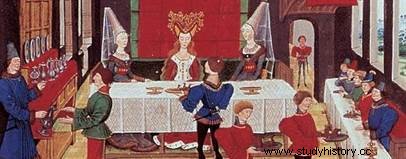 The maniguette or seed of paradise is said to originate from the western coast of Africa, the coast of Malaguette, bordering of the Gulf of Guinea. She was unknown to the Greeks and Romans as far as we know. It was in the 13th century that it left traces of its passage through Europe:in 1214, it appeared in the description of a festival in Treviso. But the use made of it suggests that it had been known there for a long time and was in fairly common use...
The maniguette or seed of paradise is said to originate from the western coast of Africa, the coast of Malaguette, bordering of the Gulf of Guinea. She was unknown to the Greeks and Romans as far as we know. It was in the 13th century that it left traces of its passage through Europe:in 1214, it appeared in the description of a festival in Treviso. But the use made of it suggests that it had been known there for a long time and was in fairly common use...
An example of a medieval menu
It was on June 24, 1425 that the bishop of Lisieux, Zanon de Castiglione, gave this splendid feast to all the clergy of the cathedral of Rouen, as well as to all the officers attached to this church, including lawyers, notaries, procurators and appariteurs of the officiality. It took place, in the manor of the bishops of Lisieux, in Rouen, depending on their exemption from Saint Cande.
Here is this menu:
Before the Archbishop of Rouen were served two covered dishes, in one of which there were cherries; the other contained three little veal pies. The same was served to all who were in the same room, and white wine was poured out to each.After that, two more dishes, also covered, were placed in front of the Archbishop. In one, there was venison, with black sauce; in the other, a fatty capon with white sauce; on the capon had been sown almonds and dragees.
Two dishes, which contained similar dishes, were served in front of the Bishop of Lisieux, but they were discovered; the same dishes were given to all the members of the Chapter, but always a dish for two canons.
At each service, we served other wines that were always better.
The turn of the roast meats came:
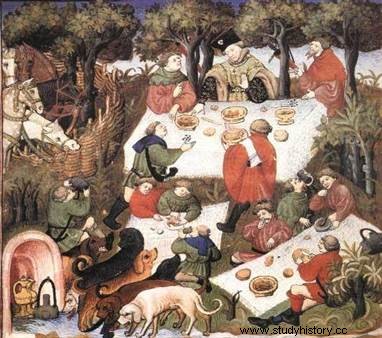 Dans le plat destiné à l'archevêque figuraient un cochon de lait, deux pluviers, un héron, la moitié d'un chevreuil, quatre poulets, quatre jeunes pigeons et un lapin, avec les assaisonnements convenables. On servit la même chose à l'évêque de Lisieux, au grand-chantre, et à l'archidiacre d'Eu. Dans chaque plat, destiné à deux chanoines, il y avait seulement un pluvier, un cochon de lait, un butor, une pièce de veau, une pièce de chevreuil, un lapin, deux poulets et deux pigeonneaux, avec des plats honnêtes de gelée. On servit aussi de ces divers mets aux chapelains et à tous les autres officiers ou subalternes de l'église, mais dans un plat pour quatre convives.
Dans le plat destiné à l'archevêque figuraient un cochon de lait, deux pluviers, un héron, la moitié d'un chevreuil, quatre poulets, quatre jeunes pigeons et un lapin, avec les assaisonnements convenables. On servit la même chose à l'évêque de Lisieux, au grand-chantre, et à l'archidiacre d'Eu. Dans chaque plat, destiné à deux chanoines, il y avait seulement un pluvier, un cochon de lait, un butor, une pièce de veau, une pièce de chevreuil, un lapin, deux poulets et deux pigeonneaux, avec des plats honnêtes de gelée. On servit aussi de ces divers mets aux chapelains et à tous les autres officiers ou subalternes de l'église, mais dans un plat pour quatre convives.
Bientôt furent apportés, avec grand apparat, quatre paons rôtis, dont on avait eu soin de conserver les queues resplendissantes de leurs riches couleurs. Puis, après quelques instants d'attente, fut servie de la venaison de sanglier en abondance, et des gâteaux de froment pétris avec du lait d'amandes.
A la fin, vinrent les fromages, les tartes et les fruits. Il y en eut pour toutes les chambres et pour toutes les tables. Les absents même n'eurent pas tort :des valets portèrent à deux chanoines, retenus par leurs infirmités, deux plats semblables à ceux qu'ils auraient eus au banquet.
Après les grâces, dites par l'archevêque, furent apportées aux convives des confitures et des épices dans des drageoirs d'argent.
Sources
- Souper mortel aux étuves de Michèle Barrière. Poche, 2009.
- Le Mesnagier de Paris :La cuisine médiévale à la fin du XIVe siècle de Josy Marty-Dufau. Heimdal, 2009.
- Le Viandier :La cuisine médiévale au XIVe siècle, Recettes d'après Taillevent de Josy Marty-Dufaut. Heimdal, 2007.
- Cuisine du Moyen Age, de Brigitte Racine. Editions Ouest-France, avril 2012.
